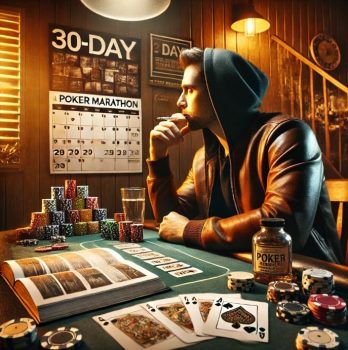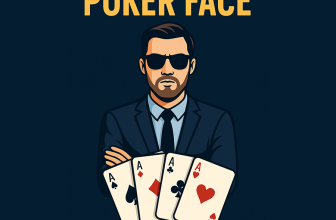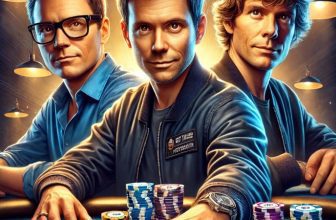"Can you learn everything in poker in 30 days? Why not! It's all about the right mindset, a training plan and a bit of persistence. Let's see if it's possible!"
Hi! Now I'm going to tell you about poker marathonthat will help you become a much stronger poker player in 30 days (or maybe less). I don't promise that you will become a world champion overnight, but if you want to raise the your skills from zero (or almost zero) to a confident level - this article is for you.
We'll cover everything from basic rules and psychology to advanced tricks and life hacks. We'll talk about funny situations from the life of a pro, discuss how to study properly and not lose motivation. And yes, I will add a little humor to make the reading process enjoyable. You ready? Let's go!
Content
Chapter 1: Why 30 days?
The essence of a "poker marathon"
"Poker Marathon" sounds like you're going to have to run with cards in hand, covering 42 kilometers. In fact, it's a metaphor: we want to do in 30 days (or less) a intense jerk in teaching poker. The thing is, a lot of people lack structure and discipline. Some people read articles, watch videos, play, but it's all chaotic. But when you have a concrete plan for 30 days, you have a clear goal.
Importance of a specific deadline
Human beings are organized in such a way that they find it easier to work with "deadlines". If I say, "Learn poker until you're tired," you're likely to procrastinate and study intermittently. But if I say, "We have exactly 30 days to learn key skills and take it to the next level," it stimulates your brain to work more efficiently. It creates excitement, and we love excitement, right?
Is it possible to become a pro in 30 days?
I'll be honest with you right off the bat: top pro (like Daniel Negreanu or Phil Ivey) in a month is a utopian task. But to get your skills up to a level where you can confidently playing at low and medium limits, earning nice money on the side and boasting your successes to your friends - it is quite realistic. The main thing is. don't be lazy and follow the plan.
Chapter 2: Day 0: Preparing for Launch
We're setting ourselves up to learn
Before we begin our poker marathonyou need to make sure you have everything you need to get off to a good start:
- Laptop or smartphone (for online poker).
- Comfortable workplace (table, chair, good lighting).
- Internet access (stable, without eternal "lags").
- Willingness to learn (watch videos, read books and articles, practice).
Choosing a poker format
There are many types of poker nowadays: Texas Hold'em, Omaha, Herd, Draw poker etc. For the marathon, we will focus on Texas Hold'embecause it is the most popular and relatively easy to learn format. But if you are more interested in Omaha, you can adapt your plan to it.
Plan and discipline
Remember: without discipline it's not going to work. It's better to spend an hour a day steadily than to sit at poker for 12 hours in a row and then do nothing for a week. So make a schedule: when you learn theory, when you watch streams or instructional videos, and when you practice at the tables.
Chapter 3: Day 1-7: Fundamentals and Basic Skills
Learning the rules and combinations
If you are already familiar with poker, you can skip this point. But if you are not, in the first couple of days you should fully master:
- Ranking of combinations (from the weakest - "senior card" to the strongest - "royal flush").
- Positions at the table (UTG, MP, CO, BTN, SB, BB) and their role.
- The main stages of trading (preflop, flop, turn, river).
Understanding positions
In poker, the position is. king. Playing out of position (on the batton or in late position) is more profitable than playing in early position. Modern professionals say, "If you want to win, learn to play out of position". In the first week, make sure you learn, how to widen and narrow ranges depending on your seat at the table.

Practice in micro-limits
Don't go for the high stakes just yet. Go to microlimits (0.01/0.02$ or so). There you can hone your base without the risk of losing serious money. Play at least 1000 hands in a week. It sounds like a lot, but it's really not much - online you can play 1000 hands in a couple or three sessions.
Homework
- Read 2-3 chapters from a classic Hold'em book (e.g. Harrington or Sklansky).
- Find tutorial channels on YouTube (e.g. Upswing Poker, Run It Once, or Russian-language counterparts) and watch a couple of videos.
- Start a notebook or document where you record interesting giveaways and thoughts.
Chapter 4. Day 8-14: Strategy and Analytics
Bankroll management
The most common mistake newbies make is that they don't know how to manage their bankroll. You win a little, you go to a higher limit and lose it all. Or "pissed away" half your budget in one night. Make a hard-and-fast rule: do not risk more than 5% of the bankroll in one session. If your bankroll is small, play at the lowest limits until you have enough money.
Handout analysis
Poker is a game where you have to constantly learn from mistakes. How do you do that?
- Record the giveaways: after the session, allocate 10-15 minutes to rewrite key hands.
- Use the software: there are programs (Holdem Manager, PokerTracker) that help you look at statistics.
- Discuss with friends or in forums: "Here I had this hand, what did I do wrong?"
The power of aggression
Many beginners are too passive: they are afraid to bet, call in the hope of "catching" something on the flop. But aggressive style usually gives you a better chance of success. If you have a good card, raise. If your opponents are weak, counter-bet them. Of course, reckless aggression is bad too, but excessive passivity - even worse.
Funny situations from the life of a pro
Professionals love to tell how they once shoved a call with "complete garbage" thinking they had "read their opponent" and ended up winning a huge pot. But this doesn't happen that often in real life. The pros usually play very disciplinedand miracle calls are the exception. So don't try to copy "movie" tricks if you don't want to get out quickly.
Chapter 5. Day 15-21: Psychology and subtleties
The mental game: how to stay adequate
Poker is as much about math as it is about psychology. Sometimes after a series of failures you start to "tilt": get angry, make stupid calls, try to win back. It is important to be able to recognize a tilt and stop in time. Take a break, get some fresh air, drink some water, calm down.
The image of a rival: reading tells
Offline, opponents have tells (involuntary gestures, facial expressions) that give away the strength or weakness of a hand. Online, this is replaced by timing, betting saisings and statistics. Learn to notice when your opponent thinks too fast or too long, how he bets, whether he changes the size of the raiser. These little things can provide a lot of information.
Lifehacks from a psychologist
- Breathing technique: before an important decision, take a deep breath-exhale, focus on the map and analyze, not your emotions.
- Autotraining: say to yourself "I'm calm, I'm playing strategy". This helps to reduce the heat of passion.
- Rewards and "penalties": think of ways to reward yourself for playing correctly (even if you lost because of a mishap) and how to "punish" yourself for breaking discipline (e.g., doing 20 push-ups).
Chapter 6. Day 22-25: In-depth Theory and Practice
ICM and tournament strategy
If you want to play not only cash but also tournaments, it's time to deal with the ICM (Independent Chip Model). This is a model that helps you understand the value of your chips at different stages of a tournament. It is very important when there are few players left and each elimination dramatically changes the prize money.
Exploit vs GTO
- Exploit: you adjust to your opponents' mistakes and exploit their weaknesses.
- GTO (Game Theory Optimal): you strive for balance and "unexploited" play when your opponent can't gain an advantage.
It's more profitable at low limits exploitThere are a lot of players who make obvious mistakes. But for long-term growth, it is useful to study GTO as well.
Advanced statistics
Use programs like PokerTracker to watch the VPIP (bank entry percentage), PFR (percentage of preflop raises), 3-bet, c-bet and other stats. The better you understand your opponents' stats, the more accurate your decisions will be.
Communicating with the community
There's a lot on the internet poker forumsThe following groups are available on social networks and Telegram feeds. There you can find like-minded peopleYou can find more players who are also going through their "poker marathon". Discuss hands, share your successes, ask for advice from more experienced players. Collective intelligence often helps you to see what you are missing.
Chapter 7. Day 26-28: Intensive Sessions and Dissection
Timed workouts
Try conducting "sprint sessions"For example, 30 minutes of continuous play on 2-3 tables, with maximum concentration. Then 10-15 minutes of rest and analysis. Repeat 3-4 times in a day. This format trains "quick reaction" and the ability to make quick decisions.
Dealing with difficult hands
Pick 5-10 of the most difficult giveaways from the last week and figure them out in detail:
- What was my range?
- What did I know about my opponent?
- What mistakes have you made?
- How should we have played optimally?
This process may take time, but it's very useful. Sometimes one in-depth analysis gives more than a hundred hands played blind.
Funny stories about the pros
For example, the famous player Phil Helmut is known for his "emotional outbursts" and loud statements at the table. And Daniel Negreanu is famous for being able to literally "read the souls" of his opponents. But behind all this is tremendous work: hours of theory, analyzing handouts, psychological training. It's not just "talent" - it's labor.
Chapter 8. Day 29-30: Final breakthrough and assessment of progress
Final tournaments and cash sessions
Toward the end of the marathon, try playing a few small buy-in tournaments (like 5-10$) or cash sessions at a limit higher than you'd normally play. Check it out, how your thinking has changedhow confident you feel at the table.
Evaluation of results
- Look at the win rate: how many big blinds per hour do you make in cash?
- Tournament successesDid you win any prizes, did you make it to the final table?
- Subjective feelingsDid you understand the game better, make faster decisions, tilt less?
Plan for the future
Poker is a road with no end in sight. Even pros with years of experience are still learning. If you see that you've grown in 30 days, but you haven't reached the level you want yet, keep the marathon going.. Set new goals: master Omaha, move up a limit, win an offline tournament.
Chapter 9. Typical mistakes of "marathon runners"
- Too much theory, not enough practice. You can burrow into books and videos, but if you don't play, progress will be minimal.
- Ignoring bankroll management. I wanted to move up fast, I went to a higher limit, and I blew it all.
- Lack of rest. Playing around the clock means you'll burn out quickly. You need a balance: sleep, walks, socializing with friends.
- Lack of analysis. If you just "skated" for 10 hours and that's it, indiscriminately, you won't learn much.
- Constant tilt. Emotions must be under control. If you feel that your nerves are on edge, stop, take a break.
Chapter 10. Funny (and instructive) situations from the life of a pro
- The Antonio Esfandiari story: he once won the biggest prize in the Big One for One Drop tournament (18+ million dollars!). But Antonio has failed many times before. He jokes that "the hardest thing in poker is to go through downswings when it feels like the whole world is against you".
- Phil Helmuth and his "flashes".: the legendary Poker Brat likes to complain loudly when he's down on his luck. But Phil holds the record for the most WSOP bracelets. His example shows that emotionality doesn't prevent you from being successful if you know how to make the switch.
- Daniel Negreanu's "Victory Dance.": they say that when he caught a lucky river, he sometimes danced a kind of salsa at the table. The audience loved it, but the opponents not so much. Lesson: humor and lightness sometimes help to cope with tension, but the main thing is not to overdo it, so as not to anger your opponents.
Chapter 11. How not to lose motivation?
- Take small breaks. When you feel tired, it's better to rest than to play in a "zombie" state.
- Set intermediate goals. For example: "Today I'm going to play 500 hands and I'm going to pick apart 5 hands where I had difficulties."
- Reward yourself. Win a nice pot or make progress - allow yourself a small treat: a delicious dessert, a walk, a new book.
- Look for support. Tell your friends about your poker journey, keep a blog or diary. A public report motivates you to keep going.
Chapter 12. Bottom line: your 30-day leap to mastery
So, in those 30 days, we've made it:
- Secure the base (combinations, positions, basic strategy).
- Master bankroll management and learn how to analyze handoffs.
- Dive into psychology: fighting tilt, reading opponents, controlling emotions.
- Touch on advanced aspects: ICM, Statistics, GTO.
- Understand how to communicate with the community and learning new things all the time.
The main thing to realize is: poker is a long-distance game. It is important not to "burn out" after the first failure and not to get euphoric after the first success. Keep balanceLearn from mistakes, be disciplined and don't forget to have fun. After all, if poker stops being interesting, the whole point is lost.
Afterword
I sincerely hope that my "poker marathon" will be useful to you. If you do it right, you can do it in a month:
- Increase the winrate at micro-limits.
- Start winning on a regular basis.
- Feel confidence and understanding of the game.
And from there, it's all in your hands. You want to go higher? Go for it! Want to just enjoy the game with your friends in the evenings? That's fine! Poker is not just about money, it's also about socializing, adrenaline and growth opportunity.
And remember: even the toughest pros were once beginners. Good luck at the tables, don't forget about humor and common sense. Let your bluffs be undiscovered and your nats bring you big pots!





